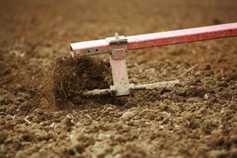Teagasc held a drainage event last Wednesday week on Alan Wood’s farm, Crossmolina, Co Mayo. The farm is the only beef farm partaking in the Teagasc Heavy Soils Programme, which is designed to demonstrate a variety of drainage practices to farmers around the country.
 Alan is a suckler-to-
weanling farmer who also has a pedigree Charolais herd. He carries just under 55 suckler cows, selling bulls and heifers as yearlings. There is a strong focus on calf quality on the farm and Alan uses 100% DIY AI. Weather has a particularly big effect on the profitability of the farming enterprise as the land type is heavy in nature. In the past few years, gross margin on the farm has varied between €520/ha and €746/ha despite the use of 100% AI and a strong focus on calf quality. The farm is fragmented into three separate holdings, two of which are close together, but those two are separated from the home farm by a few miles. As part of the programme, Alan decided to drain one of the wettest fields on the farm (photo, right).
Alan is a suckler-to-
weanling farmer who also has a pedigree Charolais herd. He carries just under 55 suckler cows, selling bulls and heifers as yearlings. There is a strong focus on calf quality on the farm and Alan uses 100% DIY AI. Weather has a particularly big effect on the profitability of the farming enterprise as the land type is heavy in nature. In the past few years, gross margin on the farm has varied between €520/ha and €746/ha despite the use of 100% AI and a strong focus on calf quality. The farm is fragmented into three separate holdings, two of which are close together, but those two are separated from the home farm by a few miles. As part of the programme, Alan decided to drain one of the wettest fields on the farm (photo, right).
Drainage
 The first step was digging trial pits (photo, right). Teagasc drainage experts advised farmers to dig at least one trial pit per hectare throughout the field, as soil type can change quickly and there may be several different issues at play in any one field which are resulting in a high water table. They advised farmers to dig test pits or holes 2.5m in depth to get a feel for the permeability of subsoil and the drainage issues at hand.
The first step was digging trial pits (photo, right). Teagasc drainage experts advised farmers to dig at least one trial pit per hectare throughout the field, as soil type can change quickly and there may be several different issues at play in any one field which are resulting in a high water table. They advised farmers to dig test pits or holes 2.5m in depth to get a feel for the permeability of subsoil and the drainage issues at hand.
On examination of the field, groundwater was entering trial pits at a depth of about 1.4 -1.7m, indicating the presence of a permeable soil layer at this depth. The decision was made to put piped field drains in place 1.7m down to target this depth and remove groundwater where it can flow freely to the drains. The purpose of this approach is to reduce the volume of water stored in the soil, lowering the water table and increasing the movement of water down through the soil. The main problem in the field was that there was no outlet for water to flow from the field so the water table remained high constantly.
The drains were dug 1.7m deep and filled with stone to within 1.2m of the soil’s surface (to ensure maximum connectivity to the permeable soil layer).
From there to the top of the drain was then back-filled with soil. Five drains were installed spanning the width of the field at different points to catch water and remove it.
The placement of the drains did not follow any set pattern and was dictated by the field contours. The distance between the pipes varied from 20m to 40m at certain points, depending on where depressions were. The drains were placed to intercept groundwater moving into the low areas.
As well as the field drains, a winged sub-soiler was used to fracture and crack the subsoil (to 0.6m) and increase water movement down through the soil. This was done when weather was suitable and ground was dry enough to crack.
The deepening of the head drains around the field and deepening the drains to create a fall through an adjoining section of the farm to create an outfall accounted for most of the costs. In some areas of the field the drains were up to 12ft deep to allow for the water to flow.
However, some problems were encountered. The daub subsoil fell away, causing some head drain banks to erode quickly.

The main drain alongside a public road had a large drainage pipe in it and was backfilled to create stability for the road (photo above). At the juncture of each pipe out of the field, a manhole was erected to allow for the investigation or maintenance of any of the pipes (photo below).

Water flow
As part of the work, the flow of water was recorded over a prolonged period. The drains were found to be removing 25,000 litres (5,500gals) of water daily from the field.
Costs
Drainage took place on eight farms as part of the programme. Alan Wood’s farm required one of the most costly methods. Figure 1 details the costs of the work on the farm. The single largest cost was the cost of digging out the head drains and drawing away the spoil. As well as those in the drained field, head drains had to extend through an adjoining part of the farm to provide outflow. This added significantly to costs.






 This is a subscriber-only article
This is a subscriber-only article














SHARING OPTIONS: